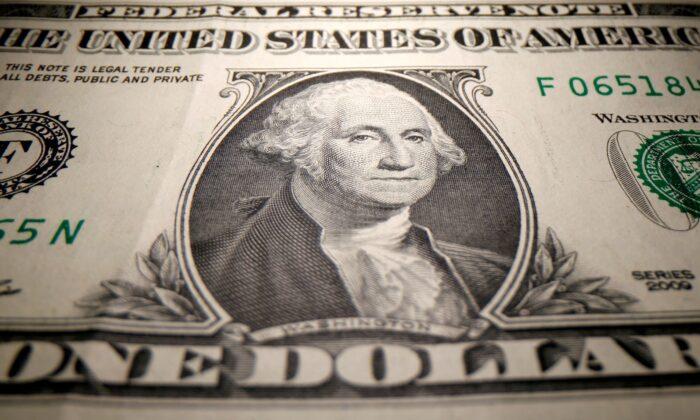LONDON—The U.S. dollar fell for a fourth consecutive day on Friday to its lowest in more than two months as investors took the view that most of the recent hawkishness from the U.S. central bank has already been priced in.
On Friday, the greenback slipped 0.2 percent to 94.62 against a basket of currencies, its lowest since early November. On a weekly basis, it is set to weaken 1.11 percent, its biggest drop since December 2020. On Thursday, it fell below a 100-day moving average for the first time since June 2021.
“The U.S. economy is firing on all cylinders, but the flattening yield curve and weaker dollar is sending a different message,” said Kenneth Broux, an FX strategist at Societe Generale in London.
“The correction of the dollar to November lows tells us investors see greater value elsewhere as earlier and more aggressive Fed tightening, embedded in rising real yields, threaten to weaken the economy and deflate asset valuations.”
Inflation-adjusted 10-year U.S. yields are up 40 bps from the start of the year, threatening to undermine a stock market rally and weigh on economic prospects.
Indeed, with hedge fund dollar positioning holding close to the highest levels since early 2020 and terminal U.S. rate pricing signaling peak rates at below 2 percent, far below the highs of previous Federal Reserve rate cycles, investors were wary of adding to long positions.
HSBC strategists said markets were increasingly concerned about the impact of the Fed’s intentions on economic growth, from the tapering and shrinking of the central bank’s balance sheet to likely higher interest rates.
“In other words, the market is unsure whether this is a good or bad thing for the USD,” they said.
Against its rivals, the dollar’s losses were most pronounced versus the Japanese yen and the Chinese yuan, against which it declined 0.4 percent and 0.3 percent respectively.
The dollar’s doldrums have escalated this week even as U.S. interest rate futures have all but locked in four rate rises this year.
But longer-dated yields have fallen slightly on hawkish comments from Fed officials about reducing the bank’s balance sheet with Fed fund futures signaling U.S. interest rates will peak by mid-2023.
The euro is up more than 1 percent for the week so far and has punched out of a range it has held since late November, hitting its highest since Nov. 11 at $1.1483. Positioning data on trading platform IG showed traders were largely neutral.
Sterling gained with the pound heading for a fourth consecutive weekly gain of more than 0.5 percent. It was last bought at $1.3730.
Cryptocurrencies stabilized after a rocky week, with prices of Bitcoin holding near their lowest levels in more than three months below $42,000.





